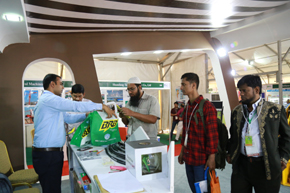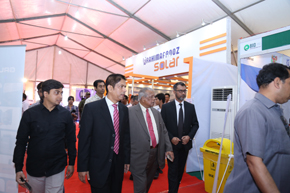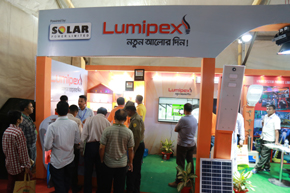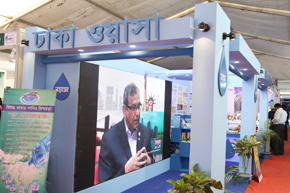BIID EXPO & DIALOGUE: Energy Efficiency and Conservation-EE&C
Energy has become one of the most important factors for better economic growth and people’s life in Bangladesh. After decades of dependency on domestic natural gas, we find ourselves not equipped with sufficient energy resources in our land, and will gradually rely on imported fuels. Also, we are well aware that the use of fossil energy increases Greenhouse Gas emission, which accelerates global warming and causes climate change, and suffers our country by natural calamities. Energy efficiency and conservation is a cross-cutting issue for all the people.
Energy Efficiency & Conservation Potential in Industrial Sector
Manufacturing industries in Bangladesh are not efficient in energy use because of continuous usage of old/ mal-maintained machines and poor energy management. We identify that, through energy intensity comparison and actual on-site energy audits, the accumulating EE&C potential in industrial sub-sectors is estimated at around 30% of the entire sector consumption. Considering that about 50% of national primary energy is consumed in industrial sector, the potential impact of EE&C measures is massive; almost 15% reduction. Therefore our focus industry is Garments & Textile | Plastic | Pharmaceuticals | Leathers and many more
Energy Efficiency & Conservation Potential in Residential Sector
If all the existing home appliances in residences are to be replaced by the highest efficiency products (as of today), huge scale of energy consumption reduction can be achieved. It is calculated that maximum potential is 36% reduction in energy consumption.
Energy Efficiency & Conservation Potential in Commercial Sector (Buildings)
Electricity is the main mode of energy in commercial buildings. In detail, nearly 50% of the total energy is consumed by ACs and 10-30% by lighting systems. It is expected that a simple replacement of ACs and lighting systems with energy efficiency ones alone can save about 50% of total electricity consumptions in the commercial sector. It should be noted, however, that luminance improvement and additional AC systems for better space condition are not included here.
Toward “Self-Reliant EE&C Society”: Target and Implementation
There are several indicators to evaluate the improvement of future national energy efficiency, such as energy consumption per capita, energy consumption per Growth Domestic Product (GDP) and the reduction amount of energy consumption, etc. Energy consumption per capita is not suitable for developing countries like Bangladesh. And in case of evaluating by the reduction amount, it is not easy to fix the national baseline in the future. Besides energy consumption per GDP can consider both the energy efficiency and increase of national economy. Therefore we will use “primary energy consumption per GDP” as an indicator to evaluate future national energy efficiency.
While identifying a huge potential, we should take practical approach to gradually realize it in phased manner since EE&C implementation requires huge investment and time. And it is estimated that with formulating suitable regulatory measures and incentive mechanisms, which are mentioned in the following pages, in accordance with nationwide actions for energy conservation, approx. 20% reduction of primary energy consumption per GDP can be achieved by 2030. And by 2021, when gas and power supply shortage is expected, 15% reduction of primary energy consumption per GDP is to be achieved. Here in the Master Plan, EE&C target and road map are set as Table 2 -1. The targets both for 2021 and 2030 are set with consideration of the EE&C potential and current energy consumption status; i.e. low electrification ratio, insufficient industry’s environmental protection measures, improvement of work condition and life style etc. Final goal of EE&C policies is to realize self-reliant cycles, rather than compulsory EE&C activities. We aim to accomplish the target, and realize a “self-reliant EE&C” society by 2030 and finally 2041.
Capacity Development and Awareness Raising
For successful implementation of EE&C initiatives, all the stakeholders such as governmental organizations, private sectors and energy experts should accurately understand the urgency and necessity on the improvement of energy efficiency. Also, close cooperation/collaboration among them is imperative. Thus, the Government is promoting awareness raising and information provision
Besides Bangladesh Government- the national leading Trade Shows and Conferences organizing private company ExpoNet Exhibition (Pvt.) Ltd. is initially advancing and taking a responsibility for the capacity development and wareness raising on the ecologically balanced Industry as well as Energy Efficiency & Conservation programs through BIID EXPO & DIALOGUE for all the stakeholders globally. Considering the importance of EE&C for our country, however, such roles are to be also taken by relevant private sectors, NPO/NGO and individuals in the long run. The final goal is that all the people and establishments take voluntary EE&C actions.
Sustainability : Concepts, Sustainable Growth, Resource Optimization, Techniques for the same.
Environment Protection : Challenges, Green Technology, Inventions and Waste Management and Recycling
Green Building : Intelligent Building Construction and Eco-Products
Energy Saving : Equipments and Technologies with Energy-efficient Innovation
Green Financing : Industrial financing to support Sustainable Industrialization
Safety : World Standard Safety and Security Products, Knowledge and Codes
Focus Products & Services; The whole process of Planning, Funding, Designing, Building, Operation, Recognition and Marketing
Power Generators Motors and Engines Energy Management
Cables Switchgears & Parts Transformers
Power tools Solar PV Cells and Modules Bio-diversity
Solar Lightings and Pumps LED Technology, Lighting Controls Lamps, Luminaires
Warning & Decorative Lights Building & Industry Construction Equipment Pharmaceuticals, Lab Testing & Clinical Equipment
Leather Products Manufacturing Equipment Appeal, Knitting, Dying, Garments and Textile Machinery Industrial, Building & factory automation
Process automation and control Robotics, turnkey solutions Cooling & Ventilation
Architectural Finishing Products Interior Decorative Products Ceramic Tiles
Glass & Glazing Locks & Handles Sanitary Fixtures & Appliances
Wood Products Facades & Cladding Wall covering- Finishes external and internal
Engineering & Design Consultancy Construction Systems & Technologies Security & Safety Systems
Steel Products Protective Coatings, Powder Green Concrete Products & Precast Structures
Plants (Batching, Cement, etc..) Landscaping & Garden Ornaments Commercial Vehicles
Construction Tools (Air, Hand & Power) Innovative Packaging, Cartons, Labeling, machines Industrial Lubricant
Water- Waste Management Household Electrical & Electronics Foundry, Furnace, Metallurgy & Welding
Tharman and Acoustic Insulation Green & Energy Efficient Commercial Factory Green & Energy Efficient Residencial Building
economic Zones and Industrial Park Telecom and Information Technology Auto & Eco-friendly Bricks Machine
Green Industry Development Cell Green Building Education & Training Institute Steel Buiding Manufacturing
WTP, ETP Research Institute Trade Promotion Department & Association
Trading on Industry Machinery Green Banking Sustainable Financing





